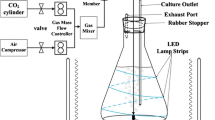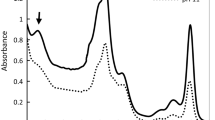Abstract
The dynamics of planktonic cyanobacteria in eutrophicated freshwaters play an important role in formation of annual summer blooms, yet overwintering mechanisms of these water bloom forming cyanobacteria remain unknown. The responses to darkness and low temperature of three strains (unicellular Microcystis aeruginosa FACHB-905, colonial M. aeruginosa FACHB-938, and a green alga Scenedesmus quadricauda FACHB-45) were investigated in the present study. After a 30-day incubation under darkness and low temperature, cell morphology, cell numbers, chlorophyll a, photosynthetic activity (ETRmax and I k), and malodialdehyde (MDA) content exhibited significant changes in Scenedesmus. In contrast, Microcystis aeruginosa cells did not change markedly in morphology, chlorophyll a, photosynthetic activity, and MDA content. The stress caused by low temperature and darkness resulted in an increase of the antioxidative enzyme-catalase (CAT) in all three strains. When the three strains re-grew under routine cultivated condition subjected to darkness and low temperature, specific growth rate of Scenedesmus was lower than that of Microcystis. Flow cytometry (FCM) examination indicated that two distinct types of metabolic response to darkness and low temperature existed in the three strains. The results from the present study reveal that the cyanobacterium Microcystis, especially colonial Microcystis, has greater endurance and adaptation ability to the stress of darkness and low temperature than the green alga Scenedesmus.






Similar content being viewed by others

References
Anderson, O. R., 1976. Respiration and photosynthesis during resting cell formation in Amphora coffeaeformis. Limnology and Oceanography 21: 452–456.
Antia, N. J. & J. Y. Cheng, 1970. The survival of axenic cultures of marine planktonic algae from prolonged exposure to darkness at 20°C. Phycologia 9: 179–183.
Asada, K., 1992. Asxorbate peroxidase—a hydrogen peroxide scavenging enzyme in plants. Physiologia Plantarum 85: 235–241.
Bradford, M., 1976. A rapid and sensitive method for the quantification of microgram quantities of protein utilizing the principle of protein-dye binding. Analytical Biochemistry 72: 248–254.
Brunberg, A. K. & P. Blomqvist, 2002. Benthic overwintering of Microcystis colonies under different environmental conditions. Journal of Plankton Research 24: 1247–1252.
Carmichael, W. W., 1994. The toxins of cyanobacteria. Scientific American 270: 78–86.
Choi, H. J., B. H. Kim, J. D. Kim & M. S. Han, 2005. Streptomyces neyagawaensis as a control for the hazardous biomass of Microcysits aeruginosa (Cyanobacteria) in eutrophic freshwaters. Biological Control 33: 335–343.
Choo, K. S., P. Snoeijs & M. Pedersén, 2004. Oxidative stress tolerance in the filamentous green algae Cladophora glomerata and Enteromorpha ahlneriana. Journal of Experimental Marine Biology and Ecology 298: 111–123.
Chu, Z., X. Jin., N. Iwami & Y. Inamori, 2007. The effect of temperature on growth characteristics and competitions of Microcystis aeruginosa and Oscillatoria mougeotii in a shallow, eutrophic lake simulator system. Hydrobiologia 581: 217–223.
Codd, G. A., J. S. Metcalf, L. F. Morrison, L. Krienitz, A. Bollot, S. Pflugmacher, C. Wiegand & K. Kotut, 2003. Susceptibility of flamingos to cyanobacterial toxins via feeding. Veterinary Record 152: 722–723.
Coles, J. F. & R. C. Jones, 2000. Effect of temperature on photosynthesis-light response and growth of four phytoplankton species isolated from a tidal freshwater river. Journal of Phycology 36: 7–16.
Dale, B., 1983. Dinoflagellate resting cysts: benthic plankton. In Fryxell, G. A. (ed.), Survival Strategies of the Algae. Cambridge University Press, Cambridge, 69–134.
Dehning, I. & M. M. Tilzer, 1989. Survival of Scenedesmus acuminatus (Chlorophyceae) in darkness. Journal of Phycology 25: 509–515.
Endo, H., J. Nakayama & T. Hayashi, 2000. Application of flow cytometry to environmental control in marine aquaculture. Materials Science and Engineering C12: 83–88.
Erdmann, N., U. Effmert, S. Fulda & S. Oheim, 1997. Effect of gravity changes on the cyanobacterium Synechocystis sp. PCC 6803. Current Microbiology 35: 348–355.
Fallon R. D. & T. D. Brock, 1981. Overwintering of Microcystis in Lake Mendota. Freshwater Biology 11: 217–226.
Furusato, E., T. Asaeda & J. Manatunge, 2004. Tolerance for prolonged darkness of three phytoplankton species, Microcystis aeruginosa (Cyanophyceae), Scenedesmus quadricauda (Chloropyceae), and Melosira ambigua (Bacillariophyceae). Hydrobiologia 527: 153–162.
Hrudey, S., S. Burch, M. Burch, M. Drikas & R. Greorgy, 1999. Remedial measures. In Chorus, I. & J. Bartram (eds.), Toxic Cyanobacteria in Water. A Guide to their Public Health Consequences, Monitoring and Management. Routledge, London, 275–312.
Huisman, J., R. R. Jonker., C. Zonneveld & F. J. Weissing, 1999. Competition for light between phytoplankton species: experimental tests of mechanistic theory. Ecology 80: 211–222.
Jochem, F. J., 1999. Dark survival strategies in marine phytoplankton assessed by cytometric measurement of metabolic activity with fluorescein diacetate. Marine Biology 135: 721–728.
Kulandaivelu, G. & H. Senger, 1976. Changes in the reactivity of the photosynthetic apparatus in heterotrophic ageing cultures of Scenedesmus obiiquus. Physiologia Plantarum 36: 157–164.
Latour, D., H. Giraudet & J.-L. Berthon, 2004a. Frequency of dividing cells and viability of Microcystis aeruginosa in sediment of a eutrophic reservoir. Aquatic Microbial Ecology 36: 117–122.
Latour, D., O. Sabido, M.-J. Salencon & H. Giraudet, 2004b. Dynamics and metabolic activity of the benthic cyanobacterium Microcystis aeruginosa in the Grangent reservoir (France). Journal of Plankton Research 26: 719–726.
Lewis, J., A. S. D. Harris, K. J. Jones & R. L. Edmonds, 1999. Long-term survival of marine planktonic diatoms and dinoflagellates in stored sediment samples. Journal of Plankton Research 21: 343–354.
Li, R., M. Watanabe & M. Watanabe, 1997. Akinate formation in plankton Anabaena spp. (Cyanobacteria) by treatment with low temperature. Journal of Phycology 33: 576–584.
Masojídek, J., J. U. Grobbelaar, L. Pechar & M. Koblízek, 2001. Photosystem electron transport rates and oxygen production in natural waterblooms of freshwater cyanobacteria during a diel cycle. Journal of Plankton Research 23: 57–66.
Maxwell, K. & G. N. Johnson, 2000. Chlorophyll fluorescence-a practical guide. Journal of Experimental Botany 345: 659–668.
Nusch, E. A., 1980. Comparison of different methods for chlorophyll and phaeopigment determination. Archiv für Hydrobiologie Beiheft Ergebnisse der Limnologie 14: 14–36.
Reynolds, C. S. & A. E. Walsby, 1975. Water blooms. Biologic Review 50: 437–481.
Reynolds, C. S., G. H. M. Jaworski, H. A. Cmiech & G. F. Leedale, 1981. On the annual cycle of the blue-green algae Microcystis aeruginosa Kütz. emend. Elenkin. Philosophical Transactions of the Royal Society of London, Series B 293: 419–477.
Schaller, A., Z. Sun, Y. Yang, A. Somoskovi & Y. Zhang, 2002. Salicylate reduces susceptibility of Mycobacterium tuberculosis to multiple antituberculosis drugs. Antimicrobial Agents and Chemotherapy 46: 2636–2639.
Sivonen, K., 1996. Cyanobacterial toxins and toxin production. Phycologia 35: 12–24.
Staehr, P. A. & M. J. Birkeland, 2006. Temperature acclimation of growth, photosynthesis and respiration in two mesophilic phytoplankton species. Phycologia 45: 648–656.
Tsujimura, S., H. Tsukada, H. Nakahara, T. Nakajima & M. Nishino, 2000. Seasonal variations of Microcystis populations in sediments of Lake Biwa, Japan. Hydrobiologia 434: 183–192.
Uchimaya, M. & M. Mihara, 1978. Determination of malonaldehyde precursor in tissues by thiobarbituric acid test. Analytical Biochemistry 86: 271–278.
Verspagen, J. M. H., E. O. F. M. Snelder, P. M. Visser, J. Huisman, L. R. Mur & B. W. Ibelings, 2004. Recruitment of benthic Microcystis (Cyanophyceae) to the water column: internal buoyancy changes or resuspension? Journal of Phycology 40: 260–270.
Verspagen, J. M. H., E. O. F. M. Snelder, P. M. Visser, K. Jöhnk, B. W. Ibelings, L. R. Mur & J. Huisman, 2005. Benthic-pelagic coupling in the population dynamics of the harmful cyanobacterium Microcystis. Freshwater Biology 50: 854–867.
Watanabe, M. M. & M. Hiroki (eds.) 1997. NIES-collection. List of strains, fifth edition, 1997. Microalgae and Protozoa. Microbial Culture Collection, National Institute for Environmental Studies, Tsukuba, 140 pp.
Wu, Z., N. Gan, Q. Huang & L. Song, 2007. Response of Microcystis to copper stress—do phenotypes of Microcystis make a difference in stress tolerance? Environmental Pollution 147: 324–330.
Zedler, J. B., 2003. Wetlands at your service: reducing impacts of agriculture at the watershed scale. Frontiers in Ecology and the Environment 1: 65–72.
Zhang, M., F. Kong, X. Shi, P. Xing & X. Tan, 2007. Differences in responses to darkness between Microcystis aeruginosa and Chlorella pyrenoidosa. Journal of Freshwater Ecology 22: 93–99.
Acknowledgments
The study was supported by the Frontier Research Project of the Chinese Academy of Science (055102-1-501), National Key Project for Basic Research (2002CB412306), and”863” Program of the Ministry of Science and Technology (2005AA60101005).
Author information
Authors and Affiliations
Corresponding author
Additional information
Handling editor: D. Hamilton
Rights and permissions
About this article
Cite this article
Wu, Z., Song, L. & Li, R. Different tolerances and responses to low temperature and darkness between waterbloom forming cyanobacterium Microcystis and a green alga Scenedesmus . Hydrobiologia 596, 47–55 (2008). https://doi.org/10.1007/s10750-007-9056-7
Received:
Revised:
Accepted:
Published:
Issue Date:
DOI: https://doi.org/10.1007/s10750-007-9056-7



